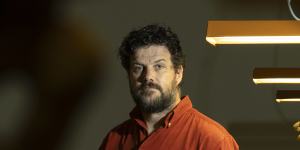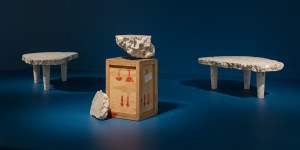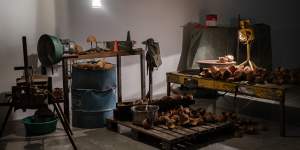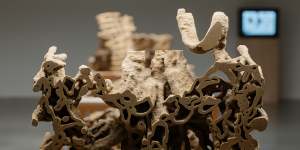
Nicholas Mangan:a superabundance of content.Janie Barrett
In the first essay in the catalogue,Amelia Barakin provides a summary that could hardly be improved upon:“All his projects involve the aggregation of different media – be it film,sculpture,photography,archival documentation,installation or sound – that crystallise around networked concepts (ecology,capitalism,colonisation,climate change),which then cross-disciplinary borders (art,neuroscience,geology,zoology,economics,politics).”
At this point,you’ll either be hooked or thinking,“Ooooh no.” After looking at Mangan’s exhibition and reading the catalogue,I’m somewhere in between. There’s formidable intelligence in this body of work and a remarkable ability to make connections between apparently disparate subjects. Yet,this doesn’t translate into outstanding art. Despite a superabundance of content,there’s no lure that catches the eye and makes one want to linger for more than the time it takes to register each component of a room-sized installation. There’s recognition but not seduction.
The first project one encounters is calledNauru – Notes from a Cretaceous World(2009-10). The Cretaceous period came to an end roughly 66 million years ago,but the key date for the island of Nauru was 1900,which saw the discovery of vast reserves of phosphate. When ownership of the mines passed into the hands of the islanders in 1970,it put them among the richest nations on earth. They celebrated in 1977 by building Nauru House,a 52-storey skyscraper in Melbourne’s CBD.
In the early 2000s the phosphate and the money ran out,obliging Nauru to sell the trophy building,completing a rags-to-riches-to-rags fairytale. Mangan has picked up the story on the way down,fulfilling an idea of an earlier Nauruan president,that lumps of coral limestone brought to Australia might be turned into coffee tables and sold for income. In this show,that dream is realised with a very rudimentary coffee table made from jagged,pale stone. It’s accompanied by photos,crates,documents and other bric-a-brac that give us a scattered impression of a tropical island,its ecology ruined by strip mining,that has been chewed up and spat out by the colonialist-capitalist machine.

A president’s dream realised:Nicholas Mangan’s Proposition for Dowiyogo’s Ancient Coral Coffee Table,2009.Hamish McIntosh
Later in the show,Mangan revisits this theme in a project calledProgress in Action (2015),looking at the island of Bougainville,where the ravages of copper mining drove the inhabitants to take up arms and fight for independence from Papua New Guinea. After their opponents cut off the supply of fuel,the Bougainvilleans fell back on making biofuel from coconuts. Mangan copied them,marvelling at how many coconuts were required for a litre.
The MCA installation includes a generator that would run on this fuel,and a lot of empty coconut shells. The centrepiece is a film loop of the conflict spliced together from footage found in the National Archives of Australia. Mangan talks about historical events informing the “sculptural gestures” he deploys,in a process he calls “material storytelling”.
This reflects an expanded conception of sculpture that may include film,archival footage and documents,or even the geographical-geological reality of a particular location. It’s a complex procedure that tends to pack too much information into every work with no clear narrative. When viewers have figured out the connections,rather than shouting “Eureka!” they’re more likely to say:“So what?”
It’s hard to get too excited about a pile of coconut shells and a ramshackle generator,even if Bougainville’s fight for independence is a story for the ages. Mangan is a purveyor of ideas,with a dry,limited sense of aesthetics. Each of the installations in this show is a comprehensive research project in which the images play a supporting role. It often feels as if these displays would be more at home in a science museum.

Bougainville’s fight for independence is a story for the ages:Progress in Action,2013.Hamish McIntosh
The main component ofA World Undone (2012) is a film of zircon particles floating against a pitch-black backdrop. It’s awe-inspiring to learn this mineral was formed 4.4 billion years ago,but not especially thrilling to watch dust blow in the wind.
The most striking memories one takes away from this show include a video of a Mexican coin,endlessly rotating (literally,the circulation of currency!);a papier-mâché model of a large disc,representing a defunct form of Micronesian stone money called Rai;a series of 3-D printed sculptures based on structures created by termites;and a stony slab made from compressed coral that glows a vivid shade of blueish purple under ultraviolet light.
Each piece is a component of a larger ensemble. One project compares a tribal currency from the Pacific with Bitcoin;another looks at the degradation and possible regeneration of the Great Barrier Reef.

Trying to crack the code:Termite Economies:Phase 3 (Rorschach) (detail),2019Hamish McIntosh
Termite Economies (2018–20) was inspired by a peculiar theory from the CSIRO,that termites might be used to help locate deposits of precious minerals. This set Mangan thinking about everything industry and technology has already learned from the insect world,and the ideas it would get from conscripting the termite armies into the mining sector. It’s only a short step to imagining how efficientallworkers would be if they had a single “hive” mind,like the ants or bees. Something like Scott Morrison’s “quiet Australians”.
There’s a degree of wit in Mangan’s reflections on termites and what capitalism might take from these creatures. As he reels off written propositions on tiny,antiquated monitors,one can feel he’s having fun,but a dystopian,science fiction fantasy looms in the background,awaiting the day when the mining companies crack the “termite code”.
What’s most attractive about Mangan’s work is his boundless curiosity and ability to take a deep interest in many different subjects and find unexpected affinities. If all that intellectual excitement translated into powerful,engaging works of art,he’d be a regular genius. Instead,his topics and ideas are often more interesting than their concrete manifestations.
One can see why the curators get excited about Mangan’s projects,because they deal with the big issues of our time and invite protracted discussion. But they have the same interest one might find in an essay,rather than an exhibition. They are monuments to fastidious research,unlikely to appeal to that proportion of viewers who expect art to be entertaining as well as enlightening. Approach this show with an open mind,but like a magazine quiz. It will help you discover whether you’re an intellectual or a hedonist.
A World Undone exhibits at the Museum of Contemporary Art until June 30.
To read more from Spectrum,.